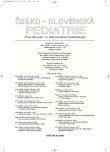Differential Diagnostics of Coagulation Disorders at the Child Age
Diferenciální diagnostika poruch koagulace v dětském věku
Hemostáza je složitá vícestupňovitá kaskáda enzymatických reakcí, jejichž prvotním impulzem je narušení celistvosti endotelu a výsledkem vznik trombu se současným spuštěním antikoagulační a fibrinolytické aktivity. Původní teorie koagulační kaskády jako linearní enzymatické aktivace je nahrazena modelem aktivní sítě simultánně probíhajících zpětnovazebných interakcí. Klíčovou úlohu v iniciální aktivaci sehrává tkáňový faktor. Ve vyšetřovacím postupu krvácivých poruch u dětí stojí na prvním místě anamnéza a fyzikální vyšetření. Z koagulačních testů stačí k rychlé diferenciální diagnostice vyšetření počtu trombocytů v kontextu kompletního krevního obrazu, aktivovaného parciálního tromboplastinového času a protrombinového času. Další testy by měly být indikovány cíleně na základě klinického podezření. Plošný laboratorní koagulační screening dětí před adenotomií a především zdravých dětí před plánovaným chirurgickým zákrokem je ve světle současných poznatků sporný a měli bychom se řídit v první řadě standardizovanou anamnézou a fyzikálním vyšetřením.
Klíčová slova:
koagulopatie, pediatrie, vyšetření, operace, adenotomie
Authors:
K. Toušovská
Authors‘ workplace:
Klinika dětské onkologie, pracoviště dětské medicíny, FN Brno
přednosta doc. MUDr. J. Štěrba, PhD.
Published in:
Čes-slov Pediat 2006; 61 (3): 137-145.
Category:
Postgraduate Education
Overview
Hemostasis is a complex multistage cascade of enzyme reactions, where the first impulse is the damage to endothelium integrity and the result is the development of a thrombus with simultaneous triggering of anticoagulant and fibrinolytic activity. The original theory of coagulation cascade as a linear enzyme reaction has been replaced by the model of an active network of simultaneously proceeding feed-back interactions. The tissue factor plays a key role in initial activation. The examination procedure of bleeding disorders in children includes, at the first place, anamnesis and physical examination. The examination of thrombocyte number is the particular coagulation test sufficient of rapid differential diagnosis within the framework of a complex blood count, activated partial prothrombine test and prothrombine time. Other tests should be indicated specifically on the basis of clinical suspicion. A flat (general) laboratory coagulation screening of children before adenotomy and, especially, the healthy children before a planned surgical intervention appears to be questionable under the present knowledge. Therefore, a standardized anamnesis and physical examination should be given priority.
Key words:
coagulopathy, pediatrics, examination, operation, adenotomy
Labels
Neonatology Paediatrics General practitioner for children and adolescentsArticle was published in
Czech-Slovak Pediatrics

2006 Issue 3
- What Effect Can Be Expected from Limosilactobacillus reuteri in Mucositis and Peri-Implantitis?
- The Importance of Limosilactobacillus reuteri in Administration to Diabetics with Gingivitis
Most read in this issue
- X-linked Adrenoleukodystrophy in Twenty One Czech Patients
- Differential Diagnostics of Coagulation Disorders at the Child Age
- Alarm Treatment for Monosymptomatic Nocturnal Enuresis
- Follow-up of Children with Unilateral Multicystic Dysplasia of Kidney
